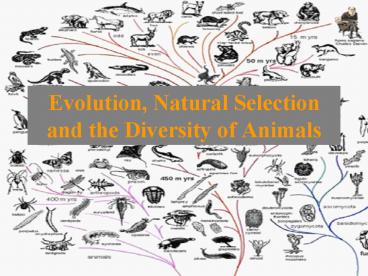Evolution, Natural Selection and the Diversity of Animals - PowerPoint PPT Presentation
1 / 24
Title:
Evolution, Natural Selection and the Diversity of Animals
Description:
Evolution, Natural Selection and the Diversity of Animals How do new species begin? DNA is instructions for all life DNA - RNA Protein Trait Mutations MAY ... – PowerPoint PPT presentation
Number of Views:135
Avg rating:3.0/5.0
Title: Evolution, Natural Selection and the Diversity of Animals
1
Evolution, Natural Selection and the Diversity of
Animals
2
How do new species begin?
- DNA is instructions for all life
- DNA -? RNA? Protein? Trait
- Mutations MAY cause changes in the production of
proteins - New traits can be passed to offspring
- May be helpful, bad or cause no change at all
3
Mutations
- Changes in the DNA sequence of nucleotides As,
G, Cs and Ts - Sickle cell anemia Harmful? Helpful?
- Albinism
- Cystic fibrosis
- Most diseases and deformities
- Blond or brunette
- 2 legs or 4 legs?
- Fins or flippers?
- Color of skin
- All differences!
4
Mutations the good, the bad, and the indifferent
- Point mutations one letter change substitution
- Frame-shift mutations insertion or deletion of
one or more nucleotides that shifts
information - each 3 code for 1 amino acid that makes up a
protein - EX cat ate the rat?catatetherat
- caatatetherat? Caa tat eth era t
- Ctatetherat? Cta tet her at
- Not all mutations are bad some make bacteria
ANTI-BIOTIC RESISTANT. - Good for the bacteria, not-so-good for you!
- Some mutations result in no change
5
Mutations can change a population
- If new traits is advantageous,
- those w/ trrait will have more successful
offspring than those without it - Over long periods of time
- populations --? new species
- Fish ? w/ lungs? move onto land? reptile?
humans! - Species groups that are so similar they can
breed with each one another and produce VIABLE
(capable of reproducing) offspring.
This is Natural Selection.
6
New species can develop if
- Members of a populations are separated from each
other (GEOGRAPHIC ISOLATION) - Members of two populations can no long breed
successfully with one another (REPRODUCTIVE
ISOLATION) - Having an abnormal number of chromosomes
(POLYPLOIDY)
7
Divergent Evolution
- One ancestral species leads to 2 new species
Marine Iguana
?
DNA
DNA
Land Iguana
Ancestral Green Iguana
8
Adaptive Radiation
- One ancestral species leads to 3 or more new
species
9
Types of Evolution
- Two ideas of how new species develop
- Gradualism lots of small changes in DNA over
long periods of time - Punctuated Equilibrium fewer, larger changes
over long periods of time.
10
Gradualism Punctuated Equilibrium
10 million years
10 million years
Notice the results of both are the same CHANGE
11
Evidence for evolution
- Antibiotic resistant bacteria
- Fossils
- Anatomy
- Embryology
- Biochemistry
- All of these methods are used together to show
relationships between species
12
Fossil Record
- Used to observe early life
- Incomplete only hard parts fossilize in
specific types of soil - Like a puzzle overall pattern
13
Anatomy
- Similarity in structures suggests relationships
between animal species - Homolgous and Analogous structures see diagram
- Vestigial structures whale pelvis
14
Homologous and Analogous Structures
- Homologous structures (homosame) alike because
they are closely related - Example bird wings, bat wings, your arm and hand
- Analogous structures (not closely related, but
same function) - - -bird wings and
- insect wings
15
Embryology
- sperm egg fertilization zygote
(1 cell) - blastula about 64 cells
- gastrulation when blastula begins to fold in
- Forms opening into gastrula
- gastrula 2 cells layers 2 tissue layers
- archenteron opening into the gastrula
16
Protostome vs Deuterostome
- If the archenteron (opening) forms into
- a mouth first PROTOSTOME
- an anus first DEUTEROSTOME
- All invertebrates (no backbone) are protostomes
except echinoderms - Vertebrates (w/backbone) and echinoderms
Deuterostomes - Humans?
17
Living things are grouped according to
similarities
- Embryology
- The more similar the
- embryonic
- development pattern the
- more closely related
18
Embryology
- Vertebrate embryos share developmental
characteristics - Post anal tails
- Pharyngeal slits or pouches
- Notochords
- Nerve cords
- DNA determines these characteristics!
19
Biochemistry
- All organisms have DNA, ATP, and other
enzymes/proteins in common - DNA is made of 4 molecules A,T,C, and G
- Similar DNA sequences similar ancestry
20
A cladogram is like a family tree showing how
things have changed.
Shows relationships based on specific
characteristics
Point where common ancestors diverged
Everything to the right of this point have
Vertebrae
21
Living things are grouped according to
similarities
Taxon Groups
- Kingdom
- Phylum
- Class
- Order
- Family
- Genus
- Species
Few similarities Largest of organisms Most
similarities Smallest of organisms
Binomial Nomenclature scientific names are Genus
and Species Ex Iguana iguana, Homo sapien
22
Living things are grouped according to
similarities
HOMOLOGOUS structures, humans, birds, porpoises
and elephants are considered more closely related
to each other than any are to insects.
23
Dichotomous keys
- Species can be identified using a dichotomous key
- Series of either / or questions leading to the
identification.
24
Dichotomous keys
Example 1. Does the flower have white or yellow
petals? -if yellow, it is a sunflower -if
white, go to question 2 2. Does the flower have a
yellow or red center? -if yellow, it is a
daisy -if red, go to question 3































